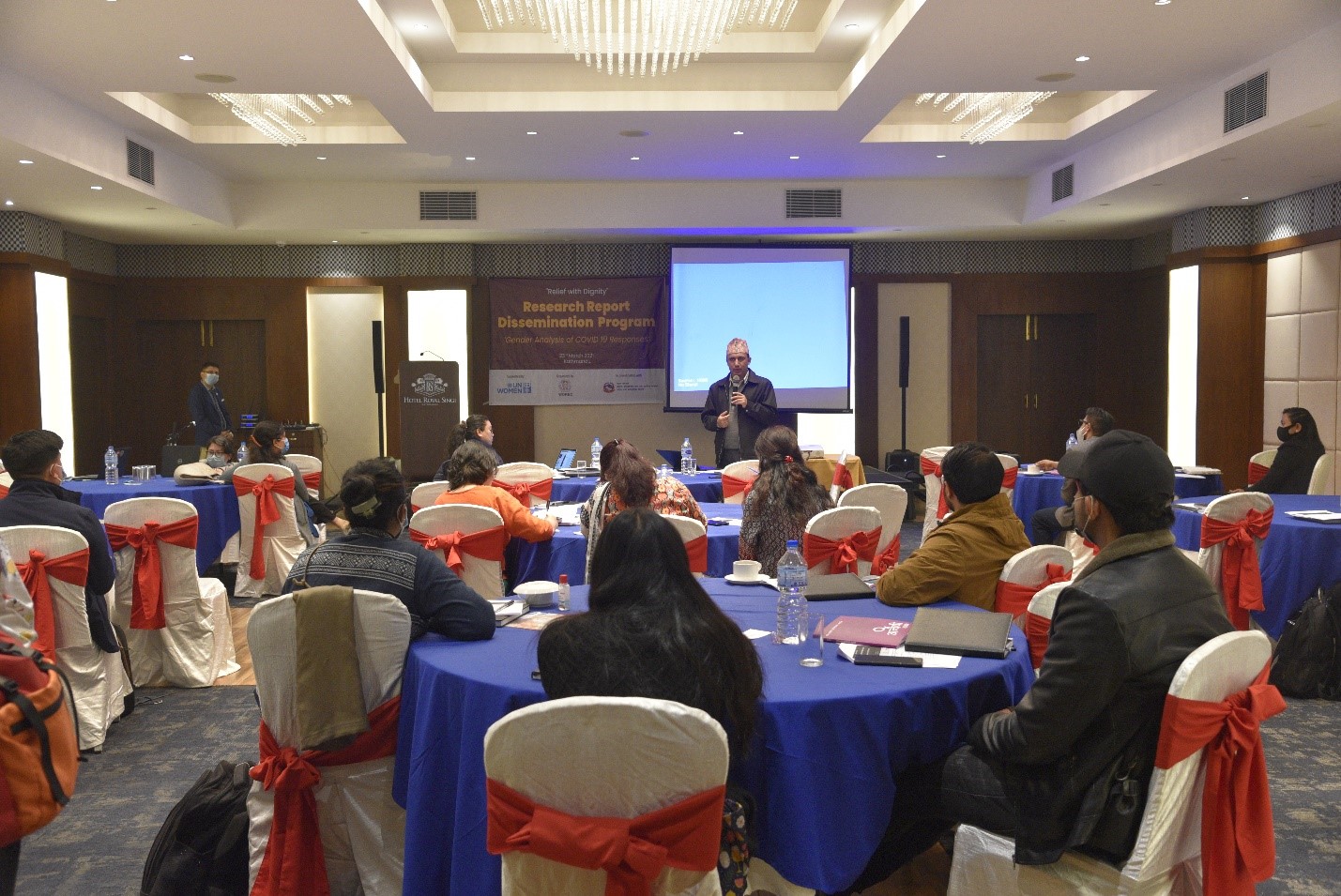
COVID 19 insurmountably magnified the wealth inequalities and exacerbated gender inequalities in Nepal. As the virus sweeps the world--shutting down businesses and schools--it appears children, gender diverse groups, girls and women, and women with intersecting identities bear the brunt of the social and economic disruption. Although the government formulated many policies, guidelines, and directives to address the health and social-economic crisis caused by the Covid-19 pandemic, many news reports suggested that the government failed to respond to the health crisis effectively and as quickly as possible.
In this regard, the research entitled 'Gender Analysis of COVID-19 Responses' was carried out by WOREC to review Covid-19 related policy, guidelines, and directives to determine their effectiveness in local responses and identify existing implementation gaps and challenges from the gender and intersectionality lens. The Local Government Units (LGU) from Kailali, Dhanusha, Mohatori, Siraha, Sarlahi, Dang, Udayapur and Morang were selected for the study.
.jpg)
Kripa Basnet, the Lead researcher, presenting the findings of the research in the program.
The National level research dissemination program of the research was held on 23rd March 2021 in coordination with the Department of Women and Children and UN Women Nepal. The program's objective was to share the research findings and recommendations with concerned government stakeholders and civil society organizations and collect their feedback. A total of 25 participants participated in the program, including the representatives from community-based organizations (CBOs), the Department of women and children, the National Human Rights Commission, academics, and the UN agency. Kripa Basnet, the Lead researcher, presented the findings of the research in the program.
According to the findings, the federal government did not consult with the Local Government Units (LGUs) to formulate Covid-19 policies, guidelines and directives while the wider public were not aware of their existence. LGUs consulted few representatives from the local organizations, but the women and adolescent girls did not have access to the information besides Coronavirus prevention and control. In such condition, many LGUs followed the federal government policies and made their policies to fit the local needs.
The study also found that the one door policy adopted to manage the Covid-19 forced local organizations to rely on LGUs to distribute the relief materials. It was also found that the distribution of relief was also met with many challenges at local levels. For instances, although LGUs reported that voter list or list of poor people were followed to prioritize the people for relief distribution, it was found that there were discrepancies in few districts. The process was politicized, which mean people close to political parties and who had access were prioritized, leading to the exclusion of many marginalized ad vulnerable populations.
The LGUs had demanded formal identity documents like citizenship card or license, which many needy people did not have. It was also difficult for LGUs to distribute relief. Many claimed that they were excluded from the list and needed to be given relief despite being financially better positioned than the daily waged labourers.
The study also reported that the participation of women and adolescent girls in Covid-19 responses was insignificant and discouraged. Women and girls faced wide restriction on their right to mobility which led them to mental stress and depression. Due to the overwhelming increase in unpaid care work, women felt trapped and burdened, causing emotional turmoil and even domestic violence.
The migrant workers who returned home were unemployed, and the economic crisis also led to violence. One woman in Siraha was burnt alive when she had requested her husband to stay in quarantine.
Regarding the conditions of quarantine facilities and isolation wards, the study found that these facilities were far from being gender-friendly. According to the quarantine, facilities constructed by LGUs did not meet the criteria due to human and financial resource crunch. Due to the lack of infrastructure, school premises were turned into quarantine facilities. However, those school premises did not have separate toilets for men and women, whereas women quarantining there were made to cook food for everyone.
In both quarantine facilities and isolation wards, people were not found to be practicing social distancing protocols. There were no sanitary napkins available for the girls and women, which is essential to maintain their menstrual hygiene.
The study's findings also show that the people who stayed in the quarantine facilities and their families were discriminated against. Along with that, the Women Human Rights Defenders (WHRDs), social mobilizers and women from marginalized backgrounds faced discrimination and were stigmatized for spreading Coronavirus.
The findings from the study shares that safe houses did not accept new survivors due to fear of getting Coronavirus while the survivors were asked to do PCR test themselves. With nowhere else to go or seek help, some were forced to flee home and hide in the field to escape domestic violence.
Health accessibility for pregnant and lactating women was of primary concern as home delivery escalated during the lockdown. The health officials refused to treat patients. The plight of women was unaddressed through the LGUs. The cases of rape and attempt to rape were not entertained and were asked to report after the lockdown is lifted. In few places, there were efforts to have monetary settlement through mediation.
Amid this, the study also found the best practices adopted by LGUs. For instance, to manage the crisis in Udayapur, many committees were formulated while one ambulance was stationed in every ward in Dang.
The study further draws out recommendations to increase the participation of women and adolescent girls in Covid-19 response and facilitate the role of women to be in decision making roles. The recommendations are also raised to have an adequate collection of data to design local policies and programs.